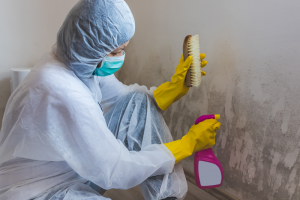
What Is Cladosporium Mold?
Cladosporium mold is one of the most common household molds. It can cause allergy and asthma flare-ups, as well as more serious infections in extreme cases. If you suspect Cladosporium mold or other mold growth, contact CLEAR Restoration for quick and efficient mold abatement and restoration.
Where Cladosporium Mold Grows
Cladosporium mold growth is commonly found on:
- Walls
- Window Sills
- Cabinets
- Carpets
Cladosporium mold typically grows in areas that are humid or wet, like bathrooms. Other places that are typically susceptible to Cladosporium growth include:
- Attics
- Near Kitchen Sinks
- Behind the Refrigerator
- Bathroom or Kitchen Cabinets
- Laundry Rooms
- Near Window Air Conditioning Units
Water damage can also lead to Cladosporium growth, as well as other, more dangerous mold growths.
[Related: Common Types of Molds]
How To Identify Cladosporium
With over 700 species of Cladosporium, it can be extremely hard for a non-professional to identify just what type of Cladosporium mold is growing in your home. Cladosporium mold is typically olive green, brown, or black.
If you notice green, brown, or black spots in areas that may have excess moisture, call CLEAR Restoration. We’ll have someone identify the suspected mold growth and the source, arrange for third-party mold testing (air and surface), and treat it, so that you can prevent potential health issues associated with Cladosporium and other molds.
Cladosporium Health Concerns
Cladosporium mold growth can cause allergic reactions in some people. If you have this type of mold in your home, you may experience:
- Itchy Eyes
- Sneezing
- Coughing
- Stuffy/Runny Nose
- Watery Eyes
If you have asthma, Cladosporium mold may cause wheezing or heighten other asthma-induced symptoms.
Preventing Cladosporium Mold
You can prevent Cladosporium mold from growing by keeping areas prone to excess moisture dry. Using a dehumidifier in typically damp places, like laundry rooms or bathrooms, can help to prevent Cladosporium mold from growing by reducing the humidity the mold needs to grow.
In areas with running water, make sure to check that there are no leaks and use anti-fungal paint on walls around sinks, tubs, or other appliances that may leak. Preventing excess moisture from reaching places like walls or carpets is the best way to ensure Cladosporium mold does not grow in your home.
Our Mold Remediation Process
Whether your mold growth is one of the many species of Cladosporium or something more toxic, like Stachybotrys (black mold), CLEAR Restoration can help you get rid of it quickly. Our six-step process ensures that your home will be properly mold-abated, ensuring a healthy living environment.
Our Six-Step Mold Abatement Process:
- Mold Inspection & Testing (we will refer a third-party, professional testing company)
- Abatement Plan
- Evacuation (if necessary)
- Containment
- Abatement
- Post-Abatement Testing (we will refer a third-party, professional testing company)
If you believe your home is infested with Cladosporium mold or any other type of mold, don’t hesitate to call the professionals at CLEAR Restoration to get the problem under control. Call us at 225-245-3575 and make your home safe again.



